Low-impact cardio workouts burn fat effectively without straining your joints — making them ideal for beginners, older adults, or anyone recovering from injury. These exercises elevate your heart rate, torch calories, and improve endurance while keeping stress off your knees, hips, and ankles.
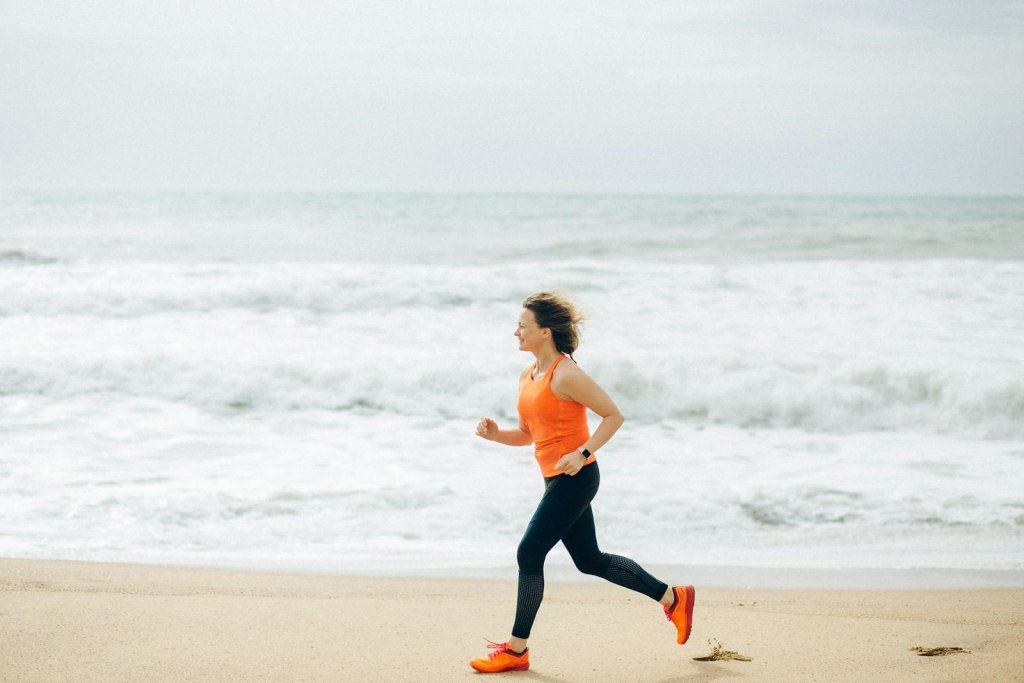
Understanding how to incorporate low-impact cardio into your routine can help you achieve lasting fat loss, boost mobility, and improve heart health — all while avoiding unnecessary pain or inflammation. Let’s explore the best options, how they work, and how to make the most of each.
What Is Low-Impact Cardio?
Low-impact cardio includes any aerobic exercise that keeps one foot on the ground (or minimizes impact) at all times. Unlike high-impact movements such as running or jumping, these workouts cushion your joints and reduce injury risk.
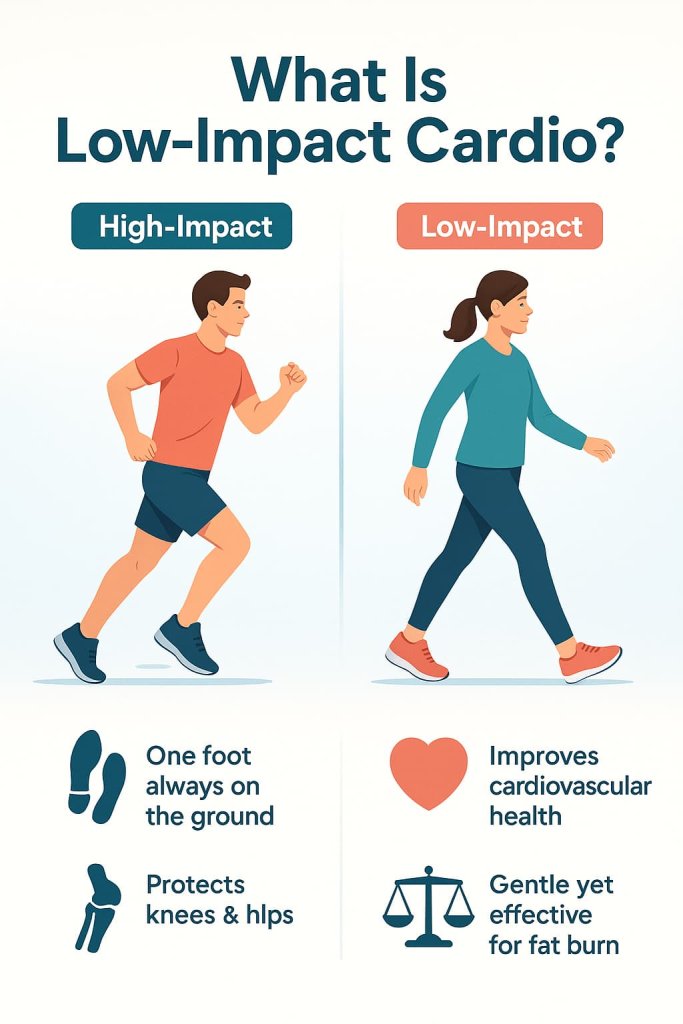
Low-impact cardio enhances circulation, supports joint mobility, and can burn 300–600 calories per session, depending on intensity and duration.
Health Benefits of Low-Impact Cardio
Low-impact workouts offer both cardiovascular and metabolic benefits.
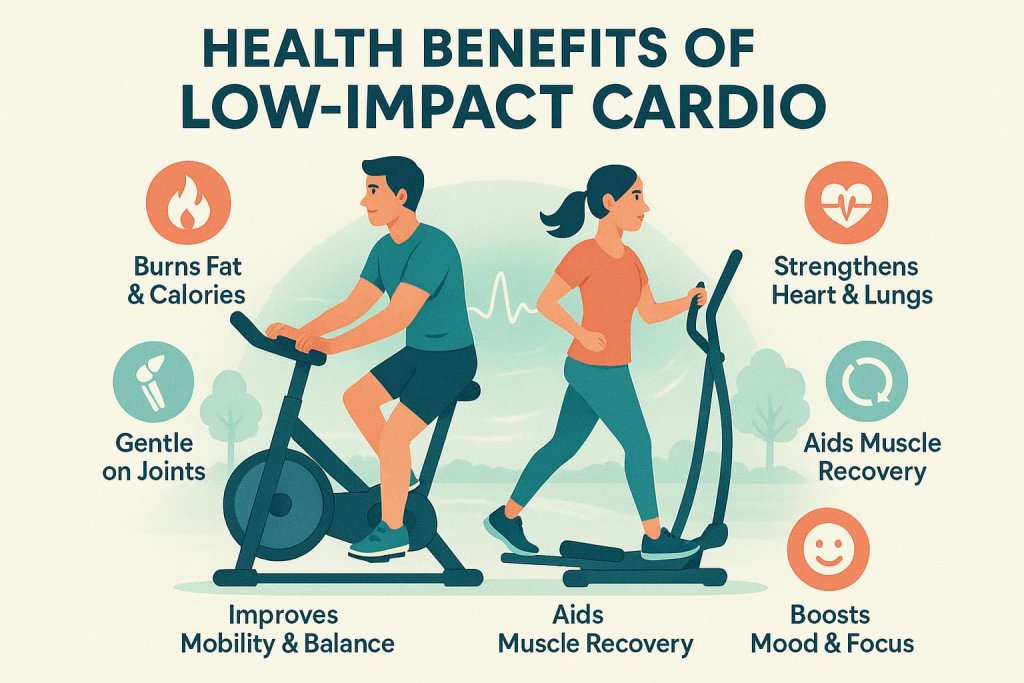
Key benefits include:
- Burns fat and calories while reducing joint stress
- Strengthens the heart and lungs
- Improves mobility, balance, and flexibility
- Reduces risk of arthritis and joint pain
- Enhances recovery between strength sessions
- Boosts mood and cognitive function
A 2024 JAMA Network Open study found that participants who performed 150 minutes of moderate-intensity cardio weekly saw significant reductions in body fat and waist circumference — even without high-impact training.
12 Best Low-Impact Cardio Workouts to Burn Fat
These 12 low-impact cardio workouts help you burn fat efficiently without stressing your joints. Each exercise boosts endurance, strengthens muscles, and supports long-term mobility.
1. Walking
Why it works:
Walking is the most accessible and sustainable form of low-impact cardio. It improves heart health, burns fat, and boosts endurance — all without pounding the joints. Research published by the American Heart Association (2024) confirms that brisk walking for at least 30 minutes a day can reduce heart-disease risk by up to 40%. Walking also helps manage blood sugar, improves mood through endorphin release, and enhances daily mobility.
Muscles worked:
Glutes, quadriceps, hamstrings, calves, core, and hip flexors.
How to do it:
- Begin with a 5-minute warm-up at an easy pace.
- Walk briskly for 30–45 minutes, keeping your posture upright and your shoulders relaxed.
- Pump your arms naturally with each stride for added calorie burn.
- For added challenge, walk uphill, on a treadmill incline, or use weighted vests for resistance.
Trainer Tip:
Switch up your terrain — combining flat, inclined, and uneven surfaces engages more stabilizing muscles and keeps your workouts stimulating.
2. Swimming
Why it works:
Swimming delivers a complete, joint-friendly cardio workout while toning and strengthening muscles through water resistance. Each stroke improves cardiovascular endurance and lung capacity. The Centers for Disease Control and Prevention (CDC, 2024) notes that swimming burns roughly 400–700 calories per hour while reducing joint stress — perfect for those with arthritis or back pain.
Muscles worked:
Shoulders, back, chest, core, glutes, quads, and hamstrings.
How to do it:
- Start with a light warm-up, then swim laps for 30–45 minutes.
- Alternate strokes: freestyle for endurance, breaststroke for chest activation, and backstroke for posture correction.
- Maintain rhythmic breathing — inhale during recovery, exhale underwater.
Trainer Tip:
Add interval sets (e.g., 2 minutes fast, 1 minute slow) to maximize calorie burn and mimic HIIT-style conditioning in the pool.
3. Cycling
Why it works:
Cycling is a top choice for cardio and lower-body toning without impact stress. It builds muscular endurance, enhances heart and lung capacity, and strengthens the core. Harvard Health (2025) estimates that moderate cycling burns 400–600 calories per hour, depending on resistance and cadence.
Muscles worked:
Quadriceps, hamstrings, glutes, calves, and core stabilizers.
How to do it:
- Use a stationary or outdoor bike.
- Maintain a cadence of 70–90 RPM for moderate intensity or push to 100+ for intervals.
- Keep knees aligned with toes and avoid hunching over the handlebars.
Trainer Tip:
Vary resistance every 5 minutes to prevent muscle adaptation. Finish with a light 5-minute spin to reduce lactic acid buildup.
4. Rowing
Why it works:
Rowing works over 80% of your body’s muscles while being completely non-impact. It strengthens the back and core, improves posture, and provides high-calorie burn (up to 700 calories/hour at vigorous intensity). Hydrow (2024) reports that consistent rowing can enhance cardiovascular endurance and reduce lower-back strain when performed correctly.
Muscles worked:
Lats, rhomboids, traps, shoulders, biceps, triceps, glutes, quads, hamstrings, and core.
How to do it:
- Sit with knees bent, grasp the handle, and engage your core.
- Push through your legs first, then pull the handle toward your chest.
- Maintain a 1:2 rhythm — drive back, recover slowly.
- Perform 20–30 minutes of steady or interval rowing.
Trainer Tip:
Keep your core braced and hinge from the hips, not the lower back, to maximize efficiency and prevent injury.
5. Elliptical Trainer
Why it works:
The elliptical provides a smooth, joint-friendly cardio option that mimics natural running motion. It enhances aerobic capacity, tones the lower body, and boosts calorie expenditure — often up to 600 calories per 45-minute session.
Muscles worked:
Glutes, hamstrings, quadriceps, calves, chest, and arms.
How to do it:
- Step onto the pedals and grip the handles.
- Maintain upright posture and steady, rhythmic motion.
- Exercise for 25–45 minutes, alternating resistance and incline.
Trainer Tip:
Push and pull equally with your arms to involve your upper body and improve overall conditioning.
6. Stair Climber
Why it works:
Climbing stairs targets your glutes and legs with controlled, low-impact effort. It’s an excellent metabolic booster that strengthens the lower body while elevating your heart rate. The motion mimics functional daily movement patterns, improving real-world mobility.
Muscles worked:
Glutes, quadriceps, hamstrings, calves, and core.
How to do it:
- Step at a controlled pace for 15–30 minutes.
- Keep your torso tall, core engaged, and use minimal support from the handrails.
Trainer Tip:
Focus on full steps (heel to toe) instead of partial movements to ensure proper muscle activation and reduce knee strain.
7. Water Aerobics
Why it works:
Water aerobics provides resistance training and cardio simultaneously, reducing joint pressure while engaging multiple muscle groups. Buoyancy protects the body, making it ideal for seniors and those recovering from injury.
Muscles worked:
Arms, shoulders, chest, core, glutes, and legs.
How to do it:
- Join a 30–45-minute group session or follow an online class.
- Perform moves such as knee lifts, side kicks, and arm circles using the water’s resistance.
Trainer Tip:
Use foam dumbbells or resistance gloves to intensify the workout and improve upper-body tone.
8. Pilates
Why it works:
Pilates strengthens deep stabilizing muscles that support your spine and joints. It enhances posture, balance, flexibility, and mind-body awareness. Research from the Journal of Bodywork & Movement Therapies (2024) shows that Pilates can improve core endurance and trunk balance after just eight weeks.
Muscles worked:
Core (transverse abdominis, obliques, rectus abdominis), glutes, hips, and shoulders.
How to do it:
- Perform a 30–45-minute mat or reformer Pilates session.
- Focus on slow, precise control through each rep.
- Engage your core before every movement.
Trainer Tip:
Prioritize quality over quantity — 10 perfect reps with full engagement outperform 30 rushed ones.
9. Dancing
Why it works:
Dance-based cardio raises your heart rate, improves coordination, and enhances mood through rhythmic movement. Studies from the Journal of Sports Medicine (2025) show dance workouts can burn 330-490 calories per hour while improving balance and flexibility.
Muscles worked:
Glutes, legs, calves, shoulders, core, and hips.
How to do it:
- Choose a dance style you enjoy — Zumba, hip-hop, or Latin dance.
- Dance continuously for 30–45 minutes, keeping your posture tall and movements fluid.
Trainer Tip:
Smile and move freely — enjoyment drives consistency, which is key to results.
10. Low-Impact HIIT (LIIT)
Why it works:
LIIT blends high-intensity interval training with joint-friendly moves. It delivers the same metabolic boost as HIIT but with gentler motions, reducing injury risk.
Muscles worked:
Full body — legs, glutes, shoulders, core, and arms.
How to do it:
- Perform 40 seconds of controlled effort, 20 seconds of rest.
- Use moves like step-backs, squats, and modified burpees.
- Continue for 20–25 minutes, maintaining intensity without jumps.
Trainer Tip:
Track your heart rate — aim for 70–85% of your maximum for maximum fat-burning efficiency.
11. Nordic Walking
Why it works:
Nordic walking engages both the upper and lower body using poles, making it more effective than standard walking. It increases energy expenditure by 20–30% while improving balance and posture.
Muscles worked:
Deltoids, triceps, lats, glutes, hamstrings, quads, and core.
How to do it:
- Use Nordic poles and maintain a steady, brisk pace for 30–45 minutes.
- Coordinate pole movement opposite to your legs (right arm/left leg).
Trainer Tip:
Engage your arms actively — the push motion strengthens shoulders and improves calorie burn dramatically.
12. Yoga Flow
Why it works:
Yoga flow enhances flexibility, balance, and core strength while offering gentle cardiovascular benefits. Vinyasa or Power Yoga keeps your heart rate elevated through continuous transitions. It’s also proven to reduce cortisol, the stress hormone linked to belly fat.
Muscles worked:
Core, glutes, hamstrings, shoulders, triceps, and back.
How to do it:
- Choose a dynamic flow like Vinyasa or Ashtanga, lasting 30–60 minutes.
- Move seamlessly between poses, focusing on breath-to-movement connection.
- End with gentle stretching or meditation for recovery.
Trainer Tip:
Prioritize fluid movement and deep breathing — this enhances oxygen flow, relaxation, and fat metabolism.
How to Get the Best Results
To burn fat effectively with low-impact cardio:
- Train 4–6 days per week for at least 150 minutes total
- Combine cardio + resistance training for faster results
- Maintain a calorie deficit and focus on whole, nutritious foods
- Prioritize sleep and hydration for optimal recovery
Sample Weekly Low-Impact Cardio Plan
| Day | Workout | Duration |
|---|---|---|
| Monday | Brisk Walking | 45 mins |
| Tuesday | Pilates or Yoga | 30 mins |
| Wednesday | Swimming | 40 mins |
| Thursday | Rest or Light Stretching | — |
| Friday | Rowing or Cycling | 35 mins |
| Saturday | Dance or Low-Impact HIIT | 30 mins |
| Sunday | Relaxed Nordic Walk | 45 mins |
Safety Tips Before You Start
- Warm up for 5–10 minutes to prepare your joints.
- Start slow, especially if you’re new or recovering.
- Listen to your body — mild soreness is fine, sharp pain is not.
- Wear cushioned, supportive footwear.
- Consult a doctor if you have chronic joint pain or mobility issues.
Who Should Try Low-Impact Cardio
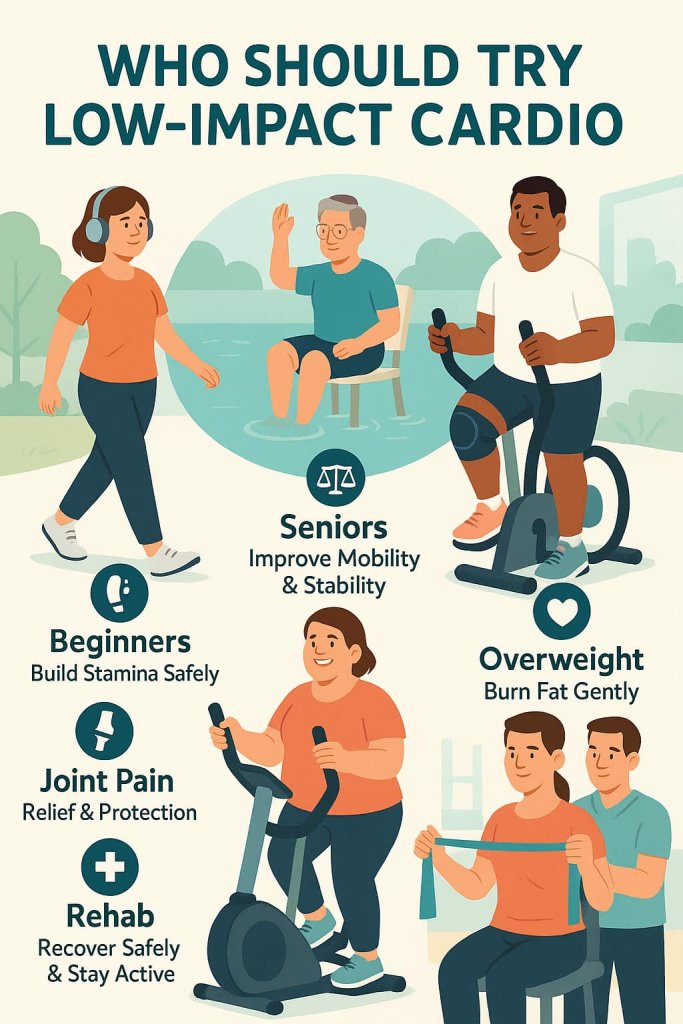
Low-impact cardio is suitable for nearly everyone — but especially beneficial for specific groups seeking safe, adaptable exercise.
1. Beginners:
People new to fitness can start with low-impact cardio to build stamina and confidence before progressing to higher intensities.
2. Seniors and Older Adults:
These workouts enhance balance, mobility, and independence while reducing the risk of falls or joint pain.
3. People with Joint or Knee Issues:
The reduced impact makes it ideal for those with arthritis, prior injuries, or chronic joint discomfort.
4. Overweight or Obese Individuals:
Gentle on the knees and hips, these exercises allow effective fat loss without pain or inflammation.
5. Recovery or Rehab Trainees:
Post-surgery or post-injury individuals can use water-based or seated low-impact exercises to maintain conditioning safely.
According to Experts, consistent low-impact activity helps strengthen connective tissue, improves circulation, and keeps muscles active during recovery periods.
How Low-Impact Cardio Burns Fat
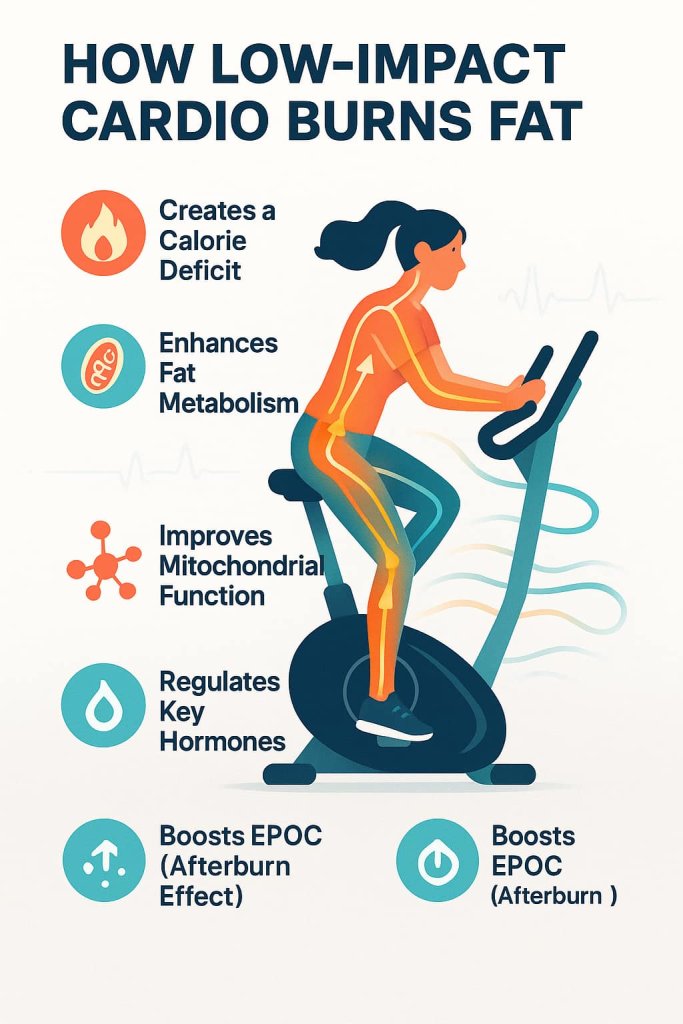
Low-impact cardio may feel gentler, but it’s a science-backed fat-burning method when performed consistently.
Here’s how it works:
- Creates a Calorie Deficit –
Even without high intensity, steady-state cardio like walking or cycling burns significant calories. Over time, this leads to stored fat being used for energy. - Enhances Fat Metabolism –
At lower heart rates (around 60–70% of max), your body relies more on fat oxidation for fuel, improving endurance and energy efficiency. - Improves Mitochondrial Function –
Research shows that low-to-moderate cardio increases mitochondrial density, allowing your body to burn fat more effectively. - Regulates Hormones –
Regular cardio stabilizes insulin, cortisol, and leptin — hormones that directly influence fat storage and appetite control. - Boosts EPOC (Afterburn Effect) –
Low-impact interval training (LIIT) raises post-exercise oxygen consumption, meaning your body continues burning calories for hours after the workout.
In short: you don’t need to jump to burn fat — you need consistency, heart-rate control, and muscle engagement.
Frequently Asked Questions
1. Can low-impact cardio help with weight loss?
Yes. As long as you maintain a calorie deficit, low-impact cardio burns fat effectively.
2. How many minutes of low-impact cardio should I do per week?
Aim for at least 150 minutes of moderate activity or 75 minutes of higher intensity.
3. What’s the best time of day for cardio?
Any time you can stay consistent — morning workouts may slightly boost metabolism.
4. Can I combine low-impact cardio with strength training?
Absolutely. Pair 3–4 cardio sessions with 2–3 strength sessions for balanced fitness.
5. Is low-impact cardio good for seniors or beginners?
Yes, it’s ideal. It improves circulation, mobility, and endurance without excess strain.
6. How many calories can I burn in a 30-minute session?
Depending on body weight and intensity: 200–400 calories.
7. Can I do low-impact cardio every day?
Yes — alternate intensities to allow for recovery and prevent overuse injuries.
Conclusion
Low-impact cardio workouts are the smartest way to stay fit, burn fat, and protect your joints for life. Whether you prefer walking, swimming, or Pilates, these joint-friendly movements offer sustainable results and long-term health benefits.
Start small, stay consistent, and build your endurance — your joints (and heart) will thank you.
References
- WHO — Physical Activity: Key Facts (2024): https://www.who.int/news-room/fact-sheets/detail/physical-activity
- JAMA Network Open (2024) — Aerobic Exercise & Adiposity Meta-analysis: https://jamanetwork.com/journals/jamanetworkopen/fullarticle/2828487
- PMC (2024) — Stationary Bike & Elliptical: Knee Joint Loads Biomechanics: https://pmc.ncbi.nlm.nih.gov/articles/PMC10972514/
- PMC (2021) — Nordic Walking Increases Energy Expenditure vs. Regular Walking: https://pmc.ncbi.nlm.nih.gov/articles/PMC7893942/
